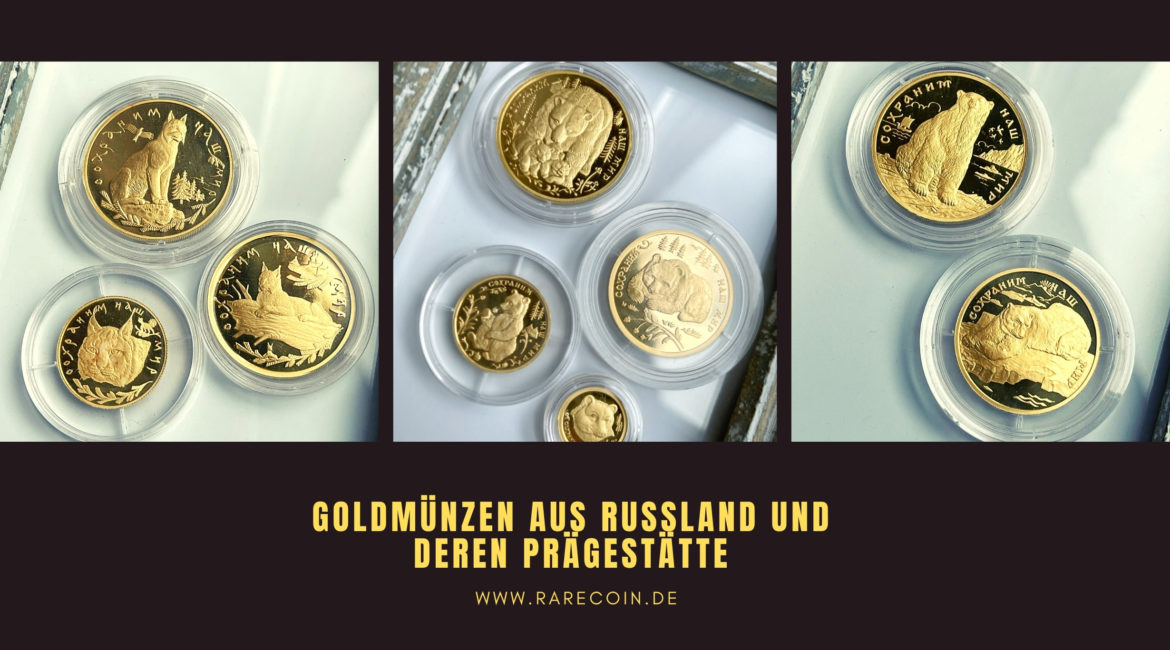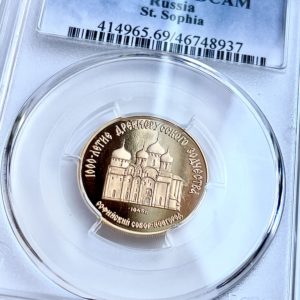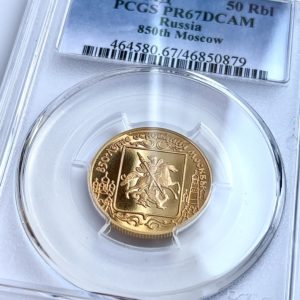Commemorative and bullion coins of the Bank of Russia / Bank Rossii
The Bank of Russia , or Bank Rossii , as the bank is known in Russia, mints commemorative coins made of precious and base metals, as well as bullion coins made of precious metals, which are sold both domestically and abroad. These include in particular gold coins from Russia . The Bank of Russia has been active in this field since its establishment in 1992 (previously, from 1965 to 1991, commemorative and bullion coins were issued by the State Bank of the USSR).
In 1996, Russian citizens were able to purchase new bullion coins for the first time. These were gold ducats from 1975 to 1982 of ordinary quality and a silver coin from 1995 with the image of a sable.
According to the decision of the Board of Directors of Bank Rossii of March 5, 2001, gold coins of ordinary quality and the silver coin “sable” are legal tender in the territory of the Russian Federation. It also includes new varieties of coins that have been in circulation since January 1, 1998.
In February 2006, Bank Rossii put into circulation a new gold coin with the image of St. George. In the year 2009 was released a similar silver coin.
Russian mint
The gold and silver coins of Bank Rossii, also called the Central Bank of Russia, are produced in the mints of Moscow and St. Petersburg. In Russia there are only these two mints . The coins are characterized by a high degree of artistic design and impeccable minting quality . Especially gold coins enjoy recognition and stable demand both in Russia itself and abroad. Specialized foreign numismatic publications and organizations have awarded them several times. These silver coins and gold coins are also very popular in Germany.
Saint Petersburg Mint
The St. Petersburg Mint is the oldest Russian and one of the world’s largest companies for the production of commemorative coins from precious metals, coin shapes and medals .
The St. Petersburg Mint has almost three centuries of production activity and has unique experience and traditions accumulated during this time. What is special here is that they are carefully preserved and successfully used in the manufacture of a wide range of products under the SPMD brand (St. Petersburg Monetnij Dvor = St. Petersburg Mint).
The mint is located in several buildings in the historic center of St. Petersburg on Rabbit Island and occupies a large part of the Peter and Paul Fortress.
The date of foundation of the St. Petersburg Mint is considered to be December 12, 1724. In 1899 a commemorative medal was issued with the laconic inscription “Founded by order of Emperor Peter I in 1724”. At that time Peter the Great ordered that “gold coins should be made in St. Petersburg in the fortress”. In this year the abbreviation “s.p.b.” appeared on the ruble coins for the first time, which became the distinctive mark of the St. Petersburg mintage until 1914.
In August 1941, at the beginning of World War II, most of the Mint’s equipment was evacuated to Krasnokamsk and housed on the premises of the Goznak paper mill. In connection with the Leningrad blockade and the entry of many workers of the Mint into the militia, only about forty skilled workers were sent to Krasnokamsk to build the Mint. This was subsequently put into operation in October. With its production capacity, the Krasnokamsk Mint could not meet the increased demand for medals and orders, and there was no possibility to expand it. Therefore, the Council of People’s Commissars of the USSR instructed the People’s Commissariat of Finance to establish a mint in Moscow, which was assigned production facilities on the site of the Moscow Mint.
Today, the St. Petersburg mint – the oldest enterprise of the famous Russian association Goznak – is considered a leading manufacturer of awards, orders and medals, commemorative coins of precious metals, badges and commemorative insignia.
Examples of gold coins from Russia minted in St.Petersburg Mint:
200 ruble gold coin polar bear 1997
200 ruble gold coin moose 2015
Moscow mint
Currently, Moscow mints almost all regular circulation coins, as well as half of the anniversary and commemorative coins, including those made of precious metals. In addition, coins are minted for foreign countries. Orders from private individuals are fulfilled there, state awards, badges and medals are produced.
The history of minting in Moscow is several centuries old, but April 25, 1942 is considered the founding date of the current Moscow Mint. The first task assigned to the Moscow Mint was the development and production of medals “For Bravery” and “For War Merit”, and at the end of 1942 these medals were joined by the production of the orders “Red Star” and “WWII”. In the same year, 1942, the factory began production of the Medal of Honor and Medals of Labor Honor.
In 1968, the Council of Ministers of the USSR decided to build a new production complex for the mint. Construction began in 1974 and was completed in 1983. In 1977, a dedicated mint was established to mint a series of commemorative coins for the 1980 Summer Olympics, and a minting technique was developed for minting proof coins. In October 1991, the Moscow Mint produced an issue of the first state award of the Russian Federation – the medal “Defender of Free Russia”, which was awarded to active participants of the events of August 1991.
It all started in 1993
The first issue of coins of the Russian Federation in the Moscow Mint took place in 1993. In 1996, Russia’s first 1-kilogram gold coins were produced by the MMD ( Moscow Monetnij Dvor/Moscow Mint ). The Moscow Mint mints circulation coins and commemorative coins in precious metal in proof quality (clean mirror field and matte relief) on behalf of the Central Bank of Russia. The technology of selective gold plating and enamel coating is used. Commemorative coins made of non-precious metals are produced in circulation quality.
Examples of gold coins from Russia minted in Moscow Mint:
200 ruble gold coin parliamentarism 2006
50 ruble gold coin polar bear 1997
200 ruble gold coin Leopard 2011
Coins description
The obverse of the coin (also called obverse) includes:
- the official symbols (national coat of arms, emblem of Bank Rossii, artistic symbols of Moscow), the face value of the coin,
- the year of issue is shown,
- the designation of the precious metal according to the periodic table (ag, au, pd, pt),
- the alloy class,
- the weight of the chemically pure precious metal in the coin in grams and
- the trademark of the coin manufacturer.
The reverse shows portraits of the jubilarians, images and motifs related to the theme of the coin or other symbols. There are exceptions when the denomination is on the reverse of the coin (gold coins of 1923 and 1975-1982).
The edge of the coin disc on the obverse and reverse is framed by a rim that extends beyond the relief image of both sides of the coin and has the shape of a continuous narrow ring in plan.
Embossing techniques
Proof coins are produced using a process that creates a clear, mirror-like surface and a matte relief image and lettering. As a rule, these are collector coins issued on anniversaries and commemorative days, on important events in history and modern times, or on current topics of culture, environmental protection and other similar themes. Their reverse designs are often complex and multi-layered; the inscriptions indicate the theme to which the coin issue is dedicated.
In recent years, the mints of some countries have developed a new minting technique, which creates a silk matte field on the surface of the coin and some details of the relief pattern are executed in the “proof” technique. It is called “reverse frosted”.
Currency and change coins
Ordinary quality coins are products of traditional, highly automated minting: Currency and change coins (circulating at face value as real means of payment) and coins made of precious metals for investment purposes, the circulation of which may reach several million pieces. The coins of this type have no reflective surfaces, the edges, motifs and inscriptions have the same surface texture, the reliefs do not contrast with the edges. The drawings on the backs are often simple and one-dimensional. The main requirement for such coins is that they meet the specified parameters for the weight of chemically pure precious metal, which, in turn, is ensured by the fact that they do not show mechanical damage in circulation.
Gold coins of modern Russia
1992-1999
In 1992 the first gold coins from Russia with the emblem of Bank Rossii were issued. The face value was 50 rubles and 100 rubles, and the mass of pure gold was 1/4 and 1/2 troy ounce, respectively.
In 1993 the denomination series was increased to 10, 25 and 200 rubles, and in 1996 the first 1 kg coin was issued with a denomination of 10,000 rubles.
Since 1997, a series of 1000 ruble coins dedicated to sailing ships has been issued. The basis of the gold coins of the 1990s are the series Save Our World and Russian Ballet.
2000-2005
In the first half of the 2000s, the issuance of Russian gold coins of the “Save Our World” series continued, and the minting of the “Russian Icon Painters” series began. The series consists of coins of 25, 50, 100, 200, 1000 and 10 thousand rubles. In 2002-2005, 25 and 50 rubles of the Zodiak series were minted.
2006-2010
In 2008, 25 thousand rubles weighing 3 kilograms were issued, in 2010 – 50 thousand rubles weighing 5 kilograms in honor of the 150th anniversary of Bank Rossii. 25 rubles were no longer minted. The series “Russian Icon Painters” comes to an end, a larger series of 200-ruble coins dedicated to winter sports will be issued in 2009-2010.
2011-2015
Bank Rossii continues the series “Save our world” and in 2011-2013 will issue a large series of coins on the Olympic Games in Sochi (50 rubles with sports motifs, as well as several denominations of 1000, 10000 and 25000 rubles).
2016-2020
In 2016, a second 5 kg coin will be issued to mark the 175th anniversary of savings in Russia. The design of the front was changed, replacing the emblem of Bank Rossii with the coat of arms. Coins with the FIFA Cup and the Confederations Cup are produced for the 2018 FIFA World Cup. Since 2017, the mintage of gold coins has been drastically reduced and only three types are produced per year.
2021-2022
100 rubles 2021 “Alexander Nevsky, 800. Anniversary of his birth. The reverse of the coin shows the monument to the Battle of Ice near Pskov against the background of the Pskov Kremlin, with Alexander Nevsky at the bottom in a semicircle along the edge.
In 2021 there were also 50 rubles 2021 UEFA EURO 2020 Football Championship coin. On the back is embossed logo of the European Football Championship 2020, in the background are laser engraved images of the sights of St. Petersburg.
In 2022 will be issued 50 rubles 2021 “Nizhny Novgorod, 800 years since its foundation”.
Also in 2022 there are 200 rubles 2021 nuclear-powered icebreaker Ural. On the back is a laser-engraved image of the nuclear-powered icebreaker Ural in the ice, with stars and a schematic representation of the North Pole in the background. At the bottom, the words “Atomic Icebreaker Fleet” run along the edge in a semicircle.
More information
In addition, would you like to learn more about gold coins from Russia? Or even about silver coins or platinum coins from Russia? Then please feel free to contact us. We are looking forward to your message.
-
50 Rubles 1988 – St. Sophia Cathedral in Novgorod – PCGS PR69 DCAM
950,00 €plus shippingDelivery Time: approx. 2-3 days (excluding Saturdays, Sundays and public holidays) -
50 rubles 1997 – 850 years of Moscow – PCGS PR69 DCAM
950,00 €plus shippingDelivery Time: approx. 2-3 days (excluding Saturdays, Sundays and public holidays)







